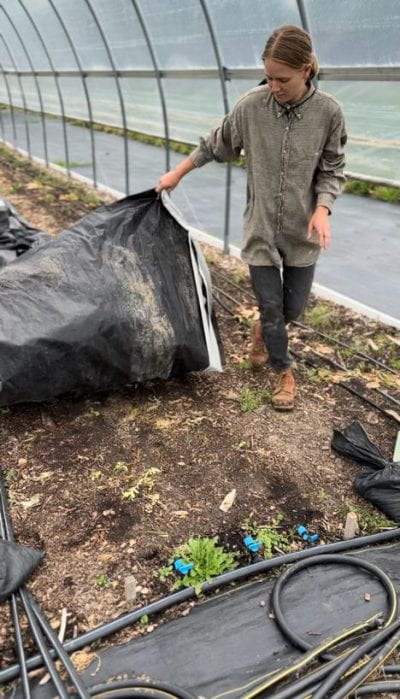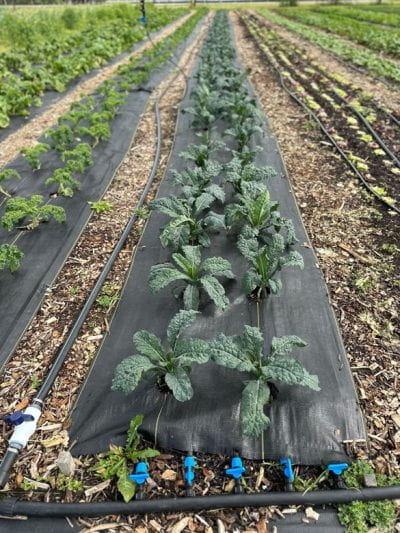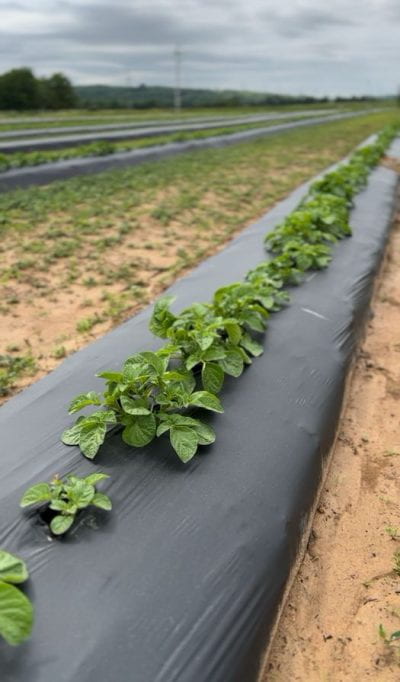Spring is upon us, temperatures are warming, and the fields are filling with crops. It is a busy time of year between field prep and planting, and there is never enough time in the day. Weeds might be the last thing on your mind this spring as you are busy planting, but we wanted to take a minute to talk about weed control strategies before we are all ankle-deep in weeds.
At the CAFF Farm, we have put into practice some very effective weed control strategies that have really paid off. And not only are these weed control strategies effective, but they are also organic and chemical-free! We’d like to share two of these strategies with you: tarping and mulching. By incorporating these strategies into our farming operations at CAFF, we have saved ourselves from spending most of the summer out in the fields weeding. And we believe these strategies are very practical for most market farmers and gardeners.

Tarping and mulching in our small-scale plots has been a very effective means of weed control.
Strategy 1: Tarping
Silage tarps are the lynchpin of our farm design and operations in our small-scale demonstration plot at CAFF. Our small-scale plots consist of blocks that are 50 by 105 feet, which are covered by two 105×25-foot silage tarps and accommodate eleven 100-foot beds per block. These silage tarps allow us to do our prep work in the fall to have weed-free beds ready to go in the spring when it is time to plant.

We tarp our field blocks after shaping and amending the beds, with the tarp held down by sandbags
Black silage tarps kill weeds by starving them of sunlight. Weed seeds will quickly germinate in the warm, moist environment created under the tarp but subsequently die when there is no sunlight to be found. In as little as two weeks, a silage tarp can create a stale seed bed for planting. Silage tarps also help deal with crop residue left after a harvest by facilitating the quick breakdown plant material. Because of this, we will also tarp our beds for one to two weeks between crops during the growing season.
By tarping our fields each winter and several times during the growing season, we are consistently working through the weed seed bank in our soil and dealing with most of the annual weeds that would become problems for us in the spring and summer. In addition, by doing most of our bed prep in the fall before tarping our fields – including incorporating compost and organic fertilizer – we are doing minimal soil disturbance in the spring, which keeps us from bringing up more weed seeds to the soil surface where they would germinate.

Tarping for one to two weeks after harvesting a crop is an effective way to get rid of crop residue before planting the next crop.
Strategy 2: Mulching
We use a few different mulches at the CAFF Farm, but they all perform a similar role for weed control: keeping the soil covered to block light and reducing the likelihood of weed seeds germinating. In our small-scale plots, we use woodchips, leaf mold, and landscape fabric as mulches. In our large-scale plots, we use black plastic mulch that we pull over our raised beds with a tractor.
In the case of organic mulches like woodchips and leaf mold it is important that perennial weeds are under control. Bermudagrass can easily grow its rhizomes through woodchips and be even more challenging to control once it has taken hold. So, it is very important that you have a degree of weed control (by tarping for instance) already in place before incorporating organic mulches.
With that consideration, we have been very pleased with our experience using woodchip mulch for our walkways between beds and using leaf mold as a mulch for our garlic. The woodchips in our walkways create a clean, weed-free path between the beds that keeps soil splash off our produce and helps to build soil quality. The leaf mold we have used to mulch our garlic has done a fantastic job with weed control and moisture retention. It also will help improve soil quality by contributing carbon to the soil and feeding soil microbes.

Leafmold has been a very effective mulch for our garlic this year for weed control.
The landscape fabric and black plastic mulch are very similar in application, with the main difference being that we can reuse the landscape fabric year after year. For our small-scale plots, the landscape fabric is an excellent fit for crops we transplant at spacing over 8 inches. With landscape fabric, you must burn holes in the material or buy it already pre-made with holes at a set spacing, but after the season, you can easily roll it up and save it for the following year. The landscape fabric is also much easier to lay out by hand, which makes it a more natural fit for smaller-scale farms.

We use landscape fabric in our small-scale plots for transplanted crops that will be in the ground for a longer period of time like this kale in the photo.
The black plastic mulch works great for our large-scale production fields, where we use a tractor to shape the beds, lay down drip tape, and pull the plastic mulch. Black plastic is much easier to poke holes in with a dibbler or tear by hand, but it is also much easier to rip accidentally. We also discovered that our large-scale field where we planted potatoes has a lot of nutsedge, which easily grew right through our black plastic mulch! These materials are not fool-proof, but they do an excellent job of keeping most weeds in check.

We use black plastic mulch for weed control in our large-scale pot.
Conclusion
Weed control is often cited as one of the most difficult aspects of organic farming. Because of the organic prohibition on synthetic herbicides, no organic sprays worth mentioning can take care of weeds. Instead, the organic farm must rely on cultural practices such as tarping and mulching for effective weed control. But the good news is that these practices actually work! And they also help build soil quality at the same time.
Another practice that can seriously improve soil quality and control weeds is cover cropping. We didn’t have time to mention cover crops here, but we will address that topic in the next blog post! In the meantime, consider how you can start incorporating tarping or mulching on your farm or in your garden this year to spend less time weeding!

Woodchips in the walkways between beds help suppress weeds and keep our crops clean.
This post written by Luke Freeman.


Recent Comments